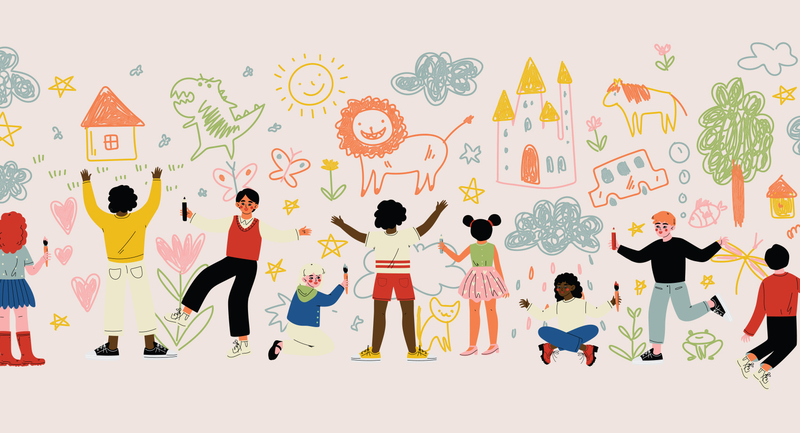Across the country, middle and high school teachers often lament, "My students don't read!" Their complaint is not that teenagers are unable to read but rather that they are unwilling. One obvious culprit, as I see it, is the smartphone.
Survey data from the Pew Research Center documents the ubiquity of these devices in teenagers' lives: 95 percent of teens have access to a smartphone and 45 percent report being online almost constantly (Anderson & Jiang, 2018). But instead of wringing our hands over students' preference for Fortnite over Fitzgerald, we would do better to focus on making our classrooms distraction-free zones where books travel from hand to hand and teenagers talk about what they are reading every day. This will entail more than simply telling students that reading is fun. We need to ensure that in our emphasis on what students should know and be able to do—the mantra of the standards movement—we remain focused on what we want students to be, readers who choose to read.
Smartphones are here to stay. Americans now spend more time looking at a mobile device than watching television (Pavia, 2019). Moreover, these devices will continue to become smarter. But so can we. Neuroscientist Maryanne Wolf suggests that today's students need to develop a biliterate reading brain, one that can navigate digital spaces with confidence without losing the ability to read slowly, deeply, and reflectively. In her book Reader, Come Home: The Reading Brain in a Digital World, she writes:
What concerns me as a scientist is whether … after multiple hours (and years) of daily screen reading, [we] are subtly changing the allocation of our attention to key processes when reading longer, more demanding text. Will our quality of attention in reading change inexorably as our culture transitions away from a print-based culture toward a digital one? (2018)
She goes on to warn that critical analysis and empathy could become the unintended collateral damage of our culture's move from print to screen.
What is a teacher to do? How can we encourage students to become more invested in books and to read them deeply and thoughtfully? I have a few suggestions. Although none of them are wildly original, taken together they can help students discover the place of reading in their lives.
Provide Students with Easy Access to Books
Many students grow up in book deserts. Just as growing up in a food desert can impact what kids eat, so limited access to books can affect students' attitudes toward reading. School and public libraries—staffed with caring librarians—are essential, but students need culturally relevant books even closer at hand. Classroom libraries allow for easy browsing before, after, and even during class.
Education leaders can establish better funding for teachers to be able to stock their shelves with new and enticing titles. Dogeared library discards won't attract a reluctant reader's attention, but a fresh, attractive cover just might. At their best, classroom libraries can be wonderfully idiosyncratic, curated to reflect the reading preferences and lived experiences of the individuals who share this space.
In my classroom library, I never tried to imitate a library's organization but instead grouped books by theme. George Takei's graphic memoir about growing up in Japanese internment camps might sit alongside historical fiction like Traci Chee's We Are Not Free. A novel like Colson Whitehead's The Nickel Boys might rest on the shelf next to Kiese Laymon's memoir Heavy. I organized texts this way in hopes that a reader drawn to one title would also pick up another.
A well-stocked classroom library sends an important message to students: we are readers here. Do I nag students to return a book that has been out for months? Of course. Do more than a few books never return to the shelves? Most certainly. My hope is that these books are so beloved that students can't give them up.
Talk About Books
Some students know few people who read for enjoyment. As an educator, you can be one of them. Begin every day with a short comment about what you are reading or by reading aloud a few pages from a book as a teaser. Greet students in the hallways with, "So what are you reading?" Carry a book with you at all times.
Talking about books provides the yeast that makes enthusiasm for reading rise. When thinking about how to pitch a book to students, I look for something that will grab their attention. For example:
- "I just finished Angie Thomas's new book On the Come Up. You won't believe this, but it is even better than The Hate U Give. Want to borrow my copy?"
- "You know Trevor Noah, the host of The Daily Show? He wrote a memoir about growing up in South Africa under apartheid. The title—Born a Crime—refers to the fact that his birth was actually a crime. His father was white and his mother was black."
- "Remember how much you liked Kwame Alexander's The Crossover? He wrote a backstory about the twins' basketball-playing dad."
As educators, we often invest too much energy threatening students with the consequences of not becoming good readers and not enough enticing them to read for their own purposes and their own pleasure. When teachers tell stories from their own reading lives about books they have read again and again, about books they have abandoned, about books that made them cry, students will wonder if there might be something between those pages for them.
Teach Students How to Talk About Their Own Reading
The book talks that have the greatest effect are those given by other students, especially ones who are not particularly known for their love of school. Teachers need to help students do this efficiently, though. Nothing is worse than a long-winded recap of the plot. Begin by modeling book talks, or if you are lucky enough to have a school librarian, invite him or her in to give a few sample book talks. Then deconstruct with students what made these short introductions to a book effective. How does a good book talk make you want to know more? The best ones successfully illustrate why a reader might choose to invest time with a story.
Once you have modeled the process, it helps to offer the class a few book talk guidelines to get started:
- Aim for a three-minute talk.
- Read from the book for up to one minute.
- Have the book with you if possible or project the cover image onto a slide.
- Do not give away the ending.
- Repeat the title and author at the conclusion of your talk.
As students hear one another talk positively about books, their interest rises. Books begin to change hands. Students are reading what they want to read.
Discount Formal Accountability
Think about the last time you finished a good book. As you turned the last page did you say to yourself, "Gosh, I'd like to answer a couple of multiple-choice questions (or write an essay)?" Neither did I. The first thing I want to do is talk about the book. Yet for students, in the name of accountability, teachers have unintentionally turned a pleasurable act into an onerous task.
Many teachers avoid independent reading because holding students accountable for their progress can be both unreliable and time-consuming. But what if we inspired readers to hold themselves accountable? Teenagers can set their own reading goals whether it is so many minutes a night, so many pages a week, or so many books a month. If they resort to SparkNotes or copy another student's reading log, they are only cheating themselves. Rather than playing the role of a warden, policing students' reading, I want to be their guide. Guides do more than simply sit back and hope students will follow their lead. For example, I routinely discuss how phones can distract us in the course of our reading and suggest ways to avoid interruption (like putting one's smartphone in another room). Reading requires focused attention.
However, I am much less interested in catching students who do not do what I expect than I am in promoting joyful reading among those who do. Point systems for keeping track of students' progress always seem to get in the way. Should I allot more points to a long, easy book or to a short, complex novel? Should students who read slowly be punished for the pace at which they turn the page? Should I give credit for rereading a book? No system I ever came up with seemed entirely fair. Nor did any point system ever properly reward what I care about most—that students become and remain readers.
I am not a believer in the "one magic book" theory—that even the most reluctant reader has simply not found the right book. In my experience, there have always been students who remain resistant to my wiles. I console myself with the thought that I have sown seeds that might not be ready to grow this school year but maybe next.
Help Students Learn How to Choose a Book
Choosing books requires the confidence to follow your instincts and take risks. I never discourage a student from a title because I think it may be too difficult for him; if it is, the student will discover that independently.
The "book pass" is one effective classroom activity for helping students learn how to browse for a book. To prepare, you need about three times as many books as you have students. The wider the variety of titles the better: novels, biographies, poetry, graphic novels, memoirs, and so on. Make sure there is also a wide range of difficulty in the pile. Randomly place a book on every student's desk and tell the class they have one minute to peruse the book and either to pass it on or hold onto it for possible reading later.
Quickly offer students who have chosen to retain a book another one to pass along. After a few passes, call for a timeout to talk about how students are making decisions about books to read. Did they check out the author's picture? What could they tell from the covers? Did the opening sentences intrigue them? Was the book jacket summary enticing? Did length matter? How much? Let students know that you hope they will find a book that seems promising over the course of the next 10 book passes.
I never insist that each student select a book, because a reader may already be in the middle of a spellbinding text. My goal is to expose students to books they may otherwise pass over and to increase their familiarity with the process of browsing books. Avid readers possess a whole set of habits of which they are mostly unaware. For instance, they are familiar with certain authors and are always on the lookout for the next Rick Riordan or Neal Gaiman volume. They aren't afraid to check out a book on account of its cover. And they invest time choosing the right book. I want to help every student develop as many of these book-browsing habits as possible.
A Life Skill
Bemoaning the ubiquity of technology is pointless. Devices will become ever more present in our students' lives. The larger problem is that too many students are choosing not to read. As a result, they are less informed, less articulate, and unfortunately, less understanding of others. Teachers need to help students learn what books, in print or online, can offer them that social media and video games do not. Reading is not simply meant for school; it is a life skill. Eighty-five years ago, a teacher in Brooklyn sent my mom home for the summer with a grocery bag full of books. At age 93, she is still reading voraciously. We can do this.







